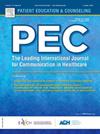Lung cancer screening: What do physicians say to reluctant patients and what do patients want them to say?
IF 2.9
2区 医学
Q2 PUBLIC, ENVIRONMENTAL & OCCUPATIONAL HEALTH
引用次数: 0
Abstract
Objective
Lung cancer screening (LCS) can detect lung cancer at an earlier stage and reduce lung cancer mortality but can also cause harm. Therefore, physicians are tasked with conveying complex information to help patients make informed decisions. Studies suggest physicians often fall short of this. We characterize how physicians respond to a patient reluctant to undergo LCS and identify communication elements patients respond favorably to.
Method
Physicians responded to a vignette of a reluctant patient. Analogue patients (APs) rated responses and described their preferred response. We analyzed both physician and AP qualitative responses using content analysis and compared mean ratings of physician responses with a particular communication element present to responses without that element.
Results
We identified 19 communication elements in 42 physician responses and 24 elements in 64 AP responses. We identified 5 elements that were associated with higher AP ratings and how often physicians engaged in them (e.g., showing desire to understand the patient as a person, occurring in 21 % of responses.)
Conclusion
We identify communication elements in physician and AP responses and reveal gaps between patients' desires and strategies employed by physicians.
Practical Implications
Findings suggest that incorporating specific communication behaviors may enhance patient receptivity regarding LCS.
求助全文
约1分钟内获得全文
求助全文
来源期刊

Patient Education and Counseling
医学-公共卫生、环境卫生与职业卫生
CiteScore
5.60
自引率
11.40%
发文量
384
审稿时长
46 days
期刊介绍:
Patient Education and Counseling is an interdisciplinary, international journal for patient education and health promotion researchers, managers and clinicians. The journal seeks to explore and elucidate the educational, counseling and communication models in health care. Its aim is to provide a forum for fundamental as well as applied research, and to promote the study of organizational issues involved with the delivery of patient education, counseling, health promotion services and training models in improving communication between providers and patients.
 求助内容:
求助内容: 应助结果提醒方式:
应助结果提醒方式:


